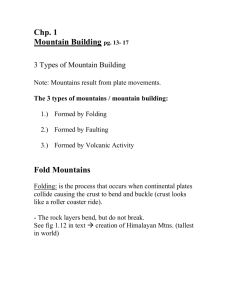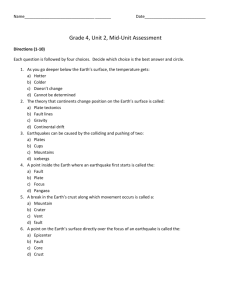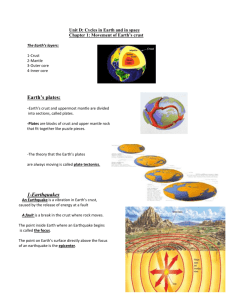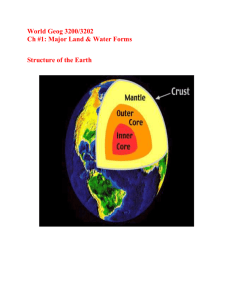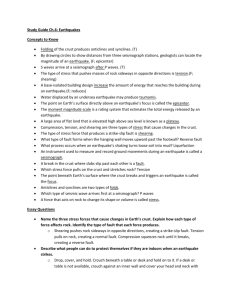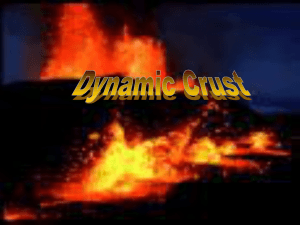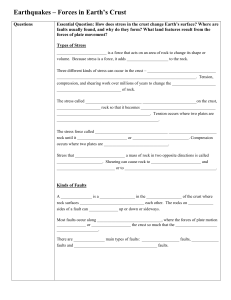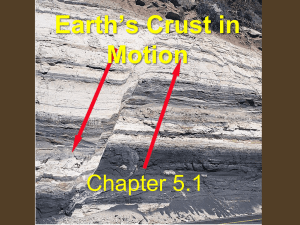blocks of crust are pulled away and one block falls down
advertisement
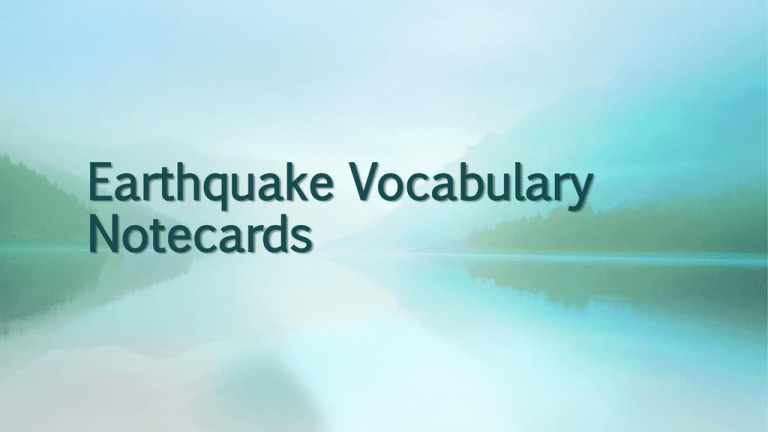
Earthquake Vocabulary Notecards Weathering • Process of breaking down the Earth’s material by natural processes of water, wind, ice, and chemicals into smaller pieces or sediments • Destructive Process Erosion • Weathered or broken down rock and other material are moved by natural processes, such as water or wind, from place to place • Destructive Movement Deposition • Process where sediments are settled or laid down in a new location • Constructive Process Constructive Force • Force that builds up features on the Earth’s surface or on an existing landform Destructive Force • Forces that destroy features on the Earth’s surface Constructive vs. Destructive Forces Venn Diagram • Weathering • Erosion • Deposition • Earthquake • Volcano • Mountains • Islands • Sand Dune • Canyon • Delta • Tsunami • Flood • Sandbar • Landslides • Glacier Focus • Point of origin underground where the rocks break producing vibrations and creating an earthquake Earth’s Surface D R A W Fault Line Epicenter • Point above ground on the surface directly above the focus Earth’s Surface D R A W Fault Line You Need: • Clicker • Checking Pen • Bad Vibrations Worksheet • Earthquake Vocabulary Notecards Compression • Force that squeezes rock or an object until it folds or breaks Tension • Force that occurs to stretch an object or rock Shear • Force that pushes a mass of rock or an object in opposite directions Fault Line Types • Normal Fault – blocks of crust are pulled away and one block falls down – Occurs at Divergent Boundary with Tension Force • Reverse Fault – blocks of crust are pushed together and one block slides up – Occurs at Convergent Boundary with Compression Force • Strike-Slip Fault – blocks of crust slide past each other with no up or down motion – Occurs at Transform Boundary with Shear Force Normal Fault Pictures **Do NOT Copy** blocks of crust are pulled away and one block falls down Reverse Fault Pictures **Do NOT Copy** blocks of crust are pushed together and one block slides up Strike-Slip Fault Pictures **Do NOT Copy** blocks of crust slide past each other with no up or down motion Types of Seismic Waves • P-Wave (Primary) – first wave from the focus – Push-pull wave that can travel through solids & liquids – Fastest wave • S-Wave (Secondary) – slow wave from the focus – Vibrates crust side to side & up or down – Travels only through solids • Surface Wave – slowest wave from the epicenter – Come from P- & S-Waves that reach the surface – Produce most damage – Stronger near the epicenter Richter Scale • Measures strength of seismic waves on a seismograph • Scale of 1-10 – 10 is the strongest – Each number is 10 times stronger than the number before Richter Scale **Do NOT Copy** When You’re Finished • BBC Plate Tectonics Test Bite **Headphones** • Fault Motion Simulations • Constructive Forces • Destructive Forces • Earthquake Interactive • Forces of Nature **Takes a Few Minutes to Load** • Beat the Quake **Headphones** • Shake, Rattle, & Slide **Headphones** Volcanoes Vocabulary Notecards Magma • Molten rock found beneath the Earth’s surface Lava • Molten rock found on the Earth’s surface Tephra • Pyroclastic material of any size rock fragments, ash, and/or dust Viscosity • Measures the thickness of molten material • High viscosity = thick • Low viscosity = more fluid Volcano Activity Levels • Active – has erupted in recent time & can erupt again at any time – Look for Seismic Activity – Example: Mt. St. Helens • Dormant – no eruption in recent time, but has a record of past eruptions – Example: Mt. Rainier in Washington • Extinct – not known to have erupted in modern history or to ever erupt again – Example: Crater Lake Types of Volcanoes • Cinder Cone – small base with steep sides – Made of Cinders – Explosive eruption • Shield – large, wide base with gentle sloping sides – Calm lava flows • Composite-Strato – tall, large, mountain-like volcano with snow cap – Alternating eruptions of lava & tephra – Explosive eruption Types of Lava • AA – hot, thin, fast flowing – Hardens with a rough, jagged edge • Pahoehoe – thicker, slow moving lava – Hardens with smooth, ropy appearance • Pillow – forms when lava erupts & cools suddenly underwater Types of Volcanic Eruptions • Determined by amount of water vapor & gases and chemical composition of magma • Explosive eruption – thick magma, high pressure/gas & water content – Example: Mt. St. Helens • Quiet eruption – fluid magma, low gas pressure & water content – Example: Hawaiian Islands Mt. Kilauea

